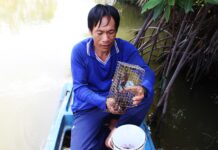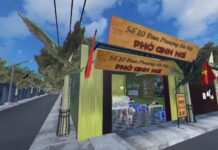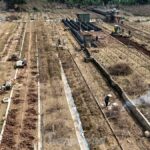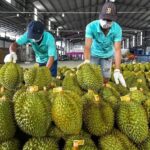Billion-dollar damage, will take a decade to rebuild
Standing on the dike of the Red River, one can see the devastation left by the floods. Hundreds of hectares of ornamental plants in Phung Cong commune, Van Giang district, Hung Yen province lie in ruins. The once vibrant fields are now covered in a dull white layer of mud, clinging to the dry, withered leaves.
Amid this desolation, some farmers are seen picking up dry branches to burn, trying to erase the traces of their immense losses and starting anew. Many shared their helplessness as they watched their precious gardens being engulfed by the rising waters. Within a few hours, the entire field was submerged. Four days of flooding brought nothing but despair. Many cried out in anguish as their entire livelihoods were washed away.
In her tea plantation, now dry and lifeless, 45-year-old Nguyen Thi Quyen from Ben village, Phung Cong commune, is clearing away the dead plants. She wants to get it done quickly so that she doesn’t have to grieve over the sight every time she visits her field. Quyen grows ancient tea plants and Japanese jasmine flowers, both high-value crops for the Tet holiday flower market. On average, she invests around VND 100 million per sao (360 square meters) for seeds, fertilizer, and labor, all of which have now been lost. “I’m planning to restore the soil and plant short-term crops for the upcoming Tet holiday,” she shared. “I can’t keep regretting and wallowing in sorrow. I have to get back on my feet and start over. After Tet, I’ll think about borrowing money to replant long-term, high-value ornamental plants.”
From Ben village, we headed to Dau village (also in Phung Cong commune). Despite the scorching sun, farmers were already in the fields, cleaning up and preparing the land for a new batch of ornamental plants. Mr. Pham Van Anh (57 years old) and his wife were sorting through the remaining intact bricks from a collapsed wall, intending to rebuild it for their garden. Anh shared that the recent flood had destroyed his two sao of precious ornamental plants, including ancient tea and magnolia trees, which could have fetched a high price. If sold today, these two sao of ancient tea plants could have brought in a revenue of VND 1 billion.

Nguyen Thi Quyen clears away the dry plants, sparing herself the grief of seeing them every time she visits her garden.
“Before, I didn’t have to lift a finger for manual labor,” Anh said. “But now that my precious plants are gone, I have to do everything myself, from restoring the garden to buying new seeds for planting. Previously, I focused solely on caring for and cultivating ancient tree varieties unique to Phung Cong. I hired people to do the soil preparation and transportation of trees. Now, with this massive loss, I’ve not only lost my capital, but the daily labor cost has also increased to VND 700,000, which I can’t afford. My wife and I have no choice but to do the work ourselves to save costs.”
Request for banks to postpone and restructure loans, and provide new loans
To restore the ornamental plant production in Phung Cong, Mr. Nguyen Quoc Tri, Chairman of the Phung Cong Commune Farmers Association, said that, for now, the People’s Committee of the commune has asked the people to clean up, disinfect, and sterilize the fields; repair technical infrastructure; and cultivate short-term ornamental plants to generate income by the end of the year.
“To rebuild the Phung Cong ornamental plant fields, the local government is requesting banks to postpone and restructure loans for the people, continue to provide credit, and increase the credit limit for people to borrow capital for reinvestment in production. At the same time, the People’s Committee of the commune is coordinating with the Institute of Plant Breeding to restore the gene sources of local ancient tree varieties,” Tri proposed.
Chử Văn Biên (50 years old, from Dau village) is applying techniques and his experience to try to save his ancient tea plants, which are over 30 years old, from the flood damage. Currently, he is focused on saving these precious trees and has not yet calculated his losses.
The people of Phung Cong are now rolling up their sleeves to rebuild their famous ornamental plant village. Mr. Pham Van Anh, a local farmer from Dau village, shared that the people of Phung Cong have always been resilient, hardworking, and persevering. Despite this setback, they will quickly recover. “It’s easy to bring back the green; within five months, the fields will be lush and full of fragrant flowers. But restoring the ancient tea and magnolia varieties will take five years, even a decade,” Anh confided.

The desolation of the largest ornamental plant village in Northern Vietnam
Mr. Do Manh Cuong (50 years old, from Dau village, Phung Cong commune) shared that, in addition to their hardworking nature, the people of Phung Cong have been growing ornamental plants for generations, and most have comfortable lives. Therefore, unless they are in debt, few will fall into hardship. The most challenging part is the amount of effort and investment required to fully restore the ornamental plant fields.
Anxious about future floods without the protective levee
In the discussion about rebuilding the Phung Cong ornamental plant village, the locals also reflected on the causes of this historic flood, the likes of which had not been seen in over 50 years. Besides the rapid rise in water levels due to heavy rains upstream, they attributed their inability to respond in time to the local government’s decision to demolish the protective levee to make way for a real estate project.
Mr. Pham Van Anh pointed to the riverbank and lamented the loss of the protective levee, which had shielded the village from countless floods and safeguarded their crops. Now, with the levee gone, the people are left feeling helpless. “For the sustainable development of the Phung Cong ornamental plant village, we request that the local authorities rebuild the protective levee so that the people can farm with peace of mind,” Anh pleaded.
Mr. Nguyen Quoc Tri, Chairman of the Phung Cong Commune Farmers Association, said that the area for growing ornamental plants outside the main dike in Phung Cong commune is about 130 hectares. The recent severe flooding caused damage to 90% of this area, with estimated economic losses of more than VND 800 million per hectare. The flood not only caused economic damage but also led to the loss of gene sources for six ancient local tea flower varieties.
Regarding flood prevention and the sustainable development of the Phung Cong ornamental plant village, Mr. Tri believes that the decision to demolish the protective levee was a mistake and should be rectified. He attributed the decision to short-sightedness, as the Red River had not experienced significant flooding in many years. “Generations of people here have painstakingly built and maintained the protective levee, just like the main dike, because you can never predict floods and natural disasters. If the protective levee were still standing, the damage from this recent flood would have been significantly reduced, and people would have had enough time to relocate their valuable plants to safety,” Tri shared sorrowfully.
The Heartbreaking Yet Determined Effort to Revive the Japanese Apricot Village After the Devastating Storm.
A blanket of smoke and fire engulfed the Nhat Tan peach garden in Hanoi as the storm raged on. The villagers, with reddened eyes, watched as the familiar trees, tended with so much dedication and care, were burned to the ground.
The Power of Insurance: A Lesson from Katrina for Vietnam’s Resilience Against Storms
In 2005, Hurricane Katrina made landfall in the United States, leaving a trail of devastation in its wake. With wind speeds exceeding 175 km/h, the storm caused immense damage, claiming the lives of over 1,800 people and resulting in economic losses of a staggering $120 billion. The impact of the hurricane was felt across the nation, with insurance companies paying out more than $40 billion to help those affected rebuild their lives and recover their assets. As the chief economist of ADB Vietnam highlighted, the storm’s aftermath led to a significant insurance payout, providing much-needed financial support to those who had lost so much.








































